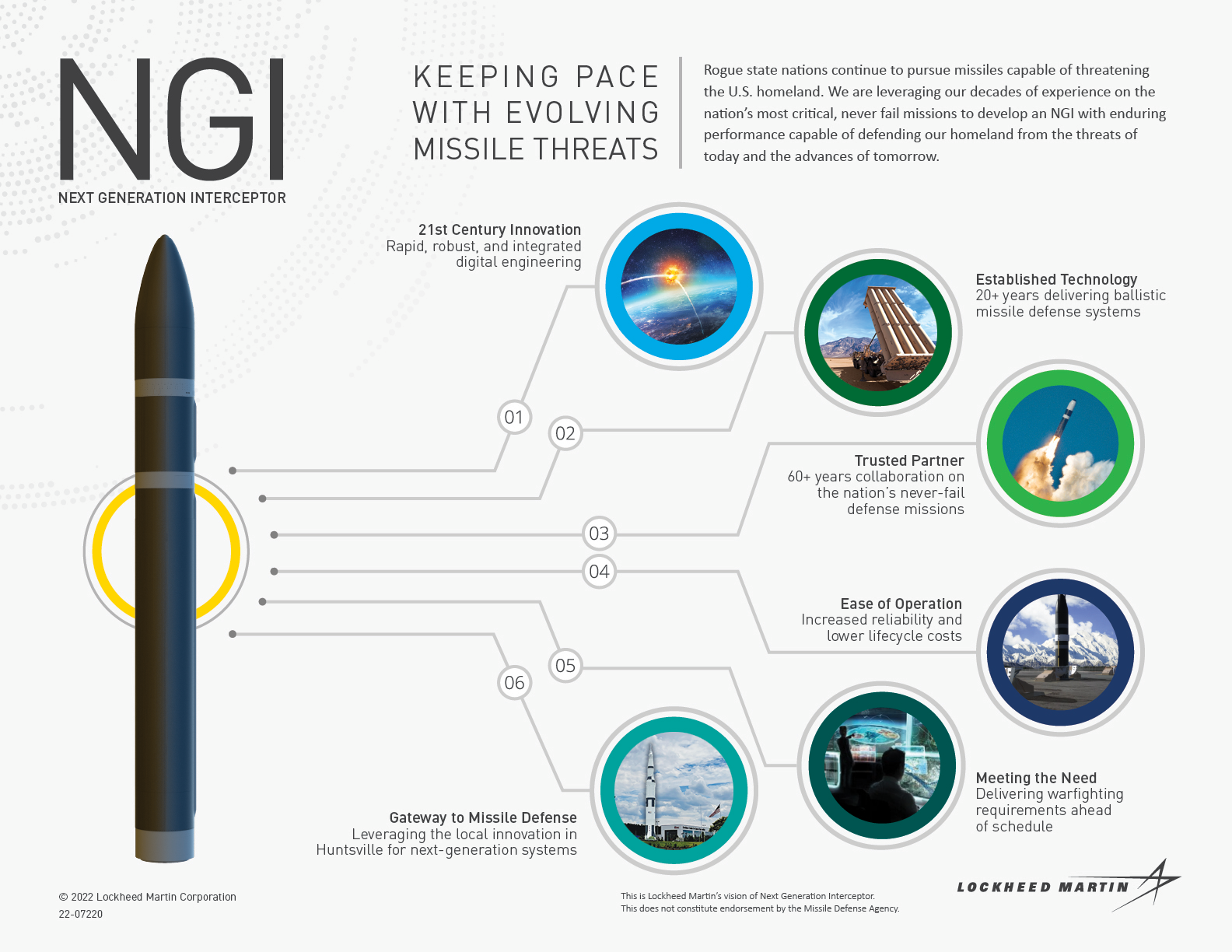The US defenses are set to become stronger as the US Missile Defense Agency (MDA) and Lockheed Martin have successfully validated the designs of Next Generation Interceptor (NGI) at an “accelerated pace.”
Lockheed said it had attained design maturity and decreased risk for important technologies through a series of successful and on-time Preliminary Design Reviews (PDRs) of all NGI major subsystems.
Next Generation Interceptor or NGI is the next generation of the MDA’s Ground-Based Missile Defense (GMD) system, which aims to defend the American homeland from threats posed by intercontinental ballistic missiles of rogue states. This development is significant as it comes amid threats from countries like China, Iran, and North Korea.
“Lockheed Martin is making rapid progress with our NGI solution, remaining on an accelerated schedule toward flight testing,” said Sarah Reeves, vice president of NGI at Lockheed Martin. “During these reviews, we took a modern and transparent approach through the use of advanced digital engineering and model-based engineering tools.”
Our NGI team will continue on-plan to demonstrate our revolutionary NGI architecture, leveraging mature technologies for high mission confidence,” she added.
The NGI program at Lockheed Martin is on schedule to undergo its upcoming thorough evaluation, the All Up Round PDR. MDA will determine if the program is prepared to advance through Knowledge Point Number One and eventually to the Critical Design Review at this upcoming major review. It is anticipated that the first Lockheed Martin NGI will be delivered to the warfighters as early as FY2027.
The development comes months after the Lockheed team announced last fall that it completed its first flight software package for its NGI demonstrator, indicating that its interceptor is rapidly progressing towards being ready for its first test flight.

It was in March of 2021 that the US Department of Defense (DoD) announced that Northrop Grumman and Lockheed Martin were awarded two contracts with a combined value of $1.6 billion to develop designs for the next generation of US missile interceptors through the end of Fiscal Year 2022.
“The Department of Defense has awarded two contracts to Northrop Grumman Systems Corporation and Lockheed Martin Corporation in support of the Next Generation Interceptor (NGI) program … With an estimated maximum value of $1.6 billion through the fiscal year 2022,” it announced at the time.
NGI is an advanced interceptor designed to protect the United States against intercontinental ballistic missile attack, and the Defense Department will uphold “fly before you buy” principles to ensure the overall system and components have been rigorously flight-tested before making any procurement decisions, the release said.
What Is The NGI Program?
The Missile Defense Agency (MDA) faces a significant problem when it comes to tracking and aiming an incoming intercontinental ballistic missile (ICBM) that is traveling through space, especially given that potential adversaries are increasingly using sophisticated decoys and countermeasures.
These aspects serve as the conceptual foundation for the Next-Generation Interceptor (NGI) program, an engineering initiative to develop new missile defense systems that can replace and advance beyond the current ground-based interceptor. The program, which has been in operation for some time, calls for next-generation equipment that is better equipped to detect and eliminate incoming ICBM threats.
To make sure interceptors can successfully detect and eliminate the right threat, a lot of effort has been spent on redesigning seekers, kill vehicles, guiding technologies, and targeting systems. This is essential because an attacking ICBM can make use of fake missile decoys that could interfere with the targeting sensors installed in a kill vehicle released from a ground-based interceptor.
Lockheed Martin, for one, presented the case for its NGI offering in an article published in Breaking Defense in 2020 by highlighting some of the drawbacks of the current ground-based midcourse defense system. The debate brought up concerns about the ground-based interceptor’s impending obsolescence and made the case that updating legacy systems to stay up with contemporary threats has its limits.

While talking about the need to upgrade the defense of Guam amid the exaggerated threat from Chinese long-range ballistic missiles like the DF-26, the head of the US Missile Defense Agency, Vice Adm. Jon Hill, said in August last year that the NGI program was vital to the Missile Defense Agency’s ground-based midcourse defense, or GMD, system.
“I will tell you both companies are saying they can get to first emplacement earlier than the government reference schedule of 2028,” said Navy Vice Adm. Jon A. Hill during a Friday discussion with Defense News. “I will tell you there is a long road between now and then. And so, we’ll just keep on the path. Both are performing very well. Two different designs, both incorporating multiple kill vehicles — that’s where the threat drives us,” he added.
With tensions running high with countries like China that can strike US assets stationed in the Pacific in case of a conflict, the need to have a next-generation interceptor has become even more strategic for the United States. The threat is amplified by an unabated testing of missiles by another US adversary, North Korea. Some of these ICBMs are believed to have the capability to strike the continental United States.
Against that backdrop, the announcement by Lockheed Martin may come as good news for the United States.
- Contact the author at sakshi.tiwari9555 (at) gmail.com
- Follow EurAsian Times on Google News




